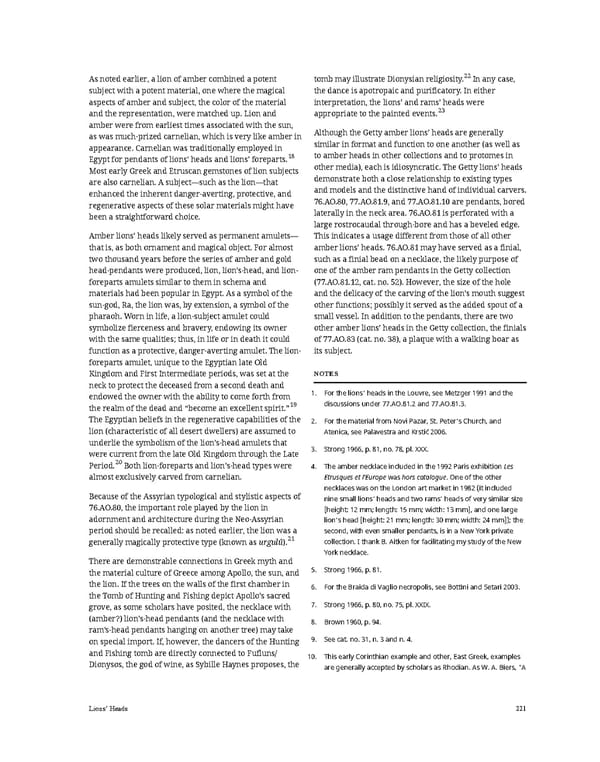As noted earlier, a lion of amber combined a potent tomb may illustrate Dionysian religiosity.22 In any case, subject with a potent material, one where the magical the dance is apotropaic and purificatory. In either aspects of amber and subject, the color of the material interpretation, the lions’ and rams’ heads were and the representation, were matched up. Lion and appropriate to the painted events.23 amber were from earliest times associated with the sun, as was much-prized carnelian, which is very like amber in Although the Getty amber lions’ heads are generally appearance. Carnelian was traditionally employed in similar in format and function to one another (as well as Egypt for pendants of lions’ heads and lions’ foreparts.18 to amber heads in other collections and to protomes in Most early Greek and Etruscan gemstones of lion subjects other media), each is idiosyncratic. The Getty lions’ heads are also carnelian. A subject—such as the lion—that demonstrate both a close relationship to existing types enhanced the inherent danger-averting, protective, and and models and the distinctive hand of individual carvers. regenerative aspects of these solar materials might have 76.AO.80, 77.AO.81.9, and 77.AO.81.10 are pendants, bored been a straightforward choice. laterally in the neck area. 76.AO.81 is perforated with a large rostrocaudal through-bore and has a beveled edge. Amber lions’ heads likely served as permanent amulets— This indicates a usage different from those of all other that is, as both ornament and magical object. For almost amber lions’ heads. 76.AO.81 may have served as a finial, two thousand years before the series of amber and gold such as a finial bead on a necklace, the likely purpose of head-pendants were produced, lion, lion’s-head, and lion- one of the amber ram pendants in the Getty collection foreparts amulets similar to them in schema and (77.AO.81.12, cat. no. 52). However, the size of the hole materials had been popular in Egypt. As a symbol of the and the delicacy of the carving of the lion’s mouth suggest sun-god, Ra, the lion was, by extension, a symbol of the other functions; possibly it served as the added spout of a pharaoh. Worn in life, a lion-subject amulet could small vessel. In addition to the pendants, there are two symbolize fierceness and bravery, endowing its owner other amber lions’ heads in the Getty collection, the finials with the same qualities; thus, in life or in death it could of 77.AO.83 (cat. no. 38), a plaque with a walking boar as function as a protective, danger-averting amulet. The lion- its subject. foreparts amulet, unique to the Egyptian late Old Kingdom and First Intermediate periods, was set at the NOTES neck to protect the deceased from a second death and endowed the owner with the ability to come forth from 1. For the lions’ heads in the Louvre, see Metzger 1991 and the the realm of the dead and “become an excellent spirit.”19 discussions under 77.AO.81.2 and 77.AO.81.3. The Egyptian beliefs in the regenerative capabilities of the 2. For the material from Novi Pazar, St. Peter’s Church, and lion (characteristic of all desert dwellers) are assumed to Atenica, see Palavestra and Krstić 2006. underlie the symbolism of the lion’s-head amulets that 3. Strong 1966, p. 81, no. 78, pl. XXX. were current from the late Old Kingdom through the Late Period.20 Both lion-foreparts and lion’s-head types were 4. The amber necklace included in the 1992 Paris exhibition Les almost exclusively carved from carnelian. Etrusques et l’Europe was hors catalogue. One of the other necklaces was on the London art market in 1982 (it included Because of the Assyrian typological and stylistic aspects of nine small lions’ heads and two rams’ heads of very similar size 76.AO.80, the important role played by the lion in [height: 12 mm; length: 15 mm; width: 13 mm], and one large adornment and architecture during the Neo-Assyrian lion’s head [height: 21 mm; length: 30 mm; width: 24 mm]); the period should be recalled: as noted earlier, the lion was a second, with even smaller pendants, is in a New York private generally magically protective type (known as urgulû).21 collection. I thank B. Aitken for facilitating my study of the New York necklace. There are demonstrable connections in Greek myth and the material culture of Greece among Apollo, the sun, and 5. Strong 1966, p. 81. the lion. If the trees on the walls of the first chamber in 6. For the Braida di Vaglio necropolis, see Bottini and Setari 2003. the Tomb of Hunting and Fishing depict Apollo’s sacred grove, as some scholars have posited, the necklace with 7. Strong 1966, p. 80, no. 75, pl. XXIX. (amber?) lion’s-head pendants (and the necklace with 8. Brown 1960, p. 94. ram’s-head pendants hanging on another tree) may take on special import. If, however, the dancers of the Hunting 9. See cat. no. 31, n. 3 and n. 4. and Fishing tomb are directly connected to Fufluns/ 10. This early Corinthian example and other, East Greek, examples Dionysos, the god of wine, as Sybille Haynes proposes, the are generally accepted by scholars as Rhodian. As W. A. Biers, “A Lions’ Heads 221
 Ancient Carved Ambers in the J. Paul Getty Museum Page 230 Page 232
Ancient Carved Ambers in the J. Paul Getty Museum Page 230 Page 232